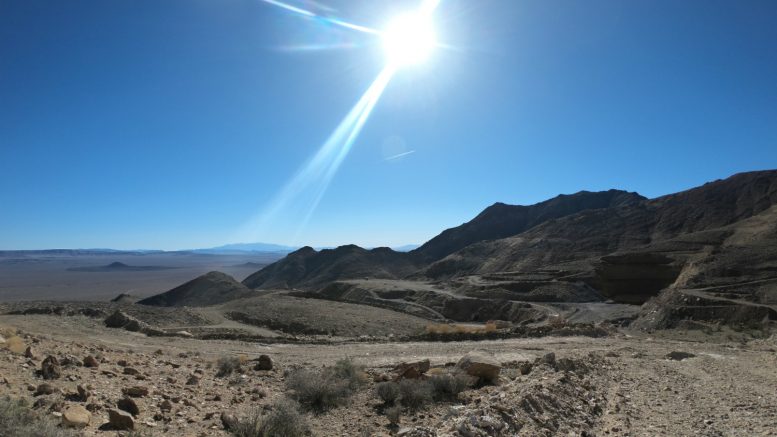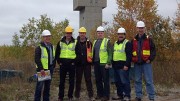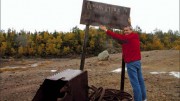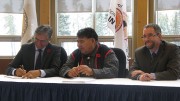LAS VEGAS, NEVADA — Out in the Nevada desert, 160 km northwest of Las Vegas and amid military facilities where soldiers pilot drones in the Middle East, and the secrets of Area 51 may hide in the sand, Northern Empire Resources (TSXV: NM; US-OTC: PSPGF) performs a delicate balancing act.
There, the company has its fully permitted, past-producing Sterling gold project, with plenty of exploration upside left.
It also has three other main targets — Daisy, Secret Pass and SNA — on its contiguous Crown Gold property.
Both Daisy and Secret Pass were mined for gold in the 1990s. SNA, however, has never been mined and is the least explored. It has only seen 149 holes, and remains open for expansion.
The question Northern Empire faced was: Take Sterling into production now, or continue exploring?
“The best return for shareholder value right now is to do the exploration,” Northern Empire president and CEO Michael Allen tells The Northern Miner.
And so Northern Empire will continue its exploration program, focusing on the Crown Gold property. In 2017, the company spent $3 million on exploration. In 2018, it intends to spend $6.5 million. It plans 10 holes for Daisy and an initial 16 for SNA, with 15 more holes permitted for Secret Pass. However, Allen says Northern Empire isn’t sure yet which target will receive the most drilling.
“If you like grade you go Daisy, if you like size you go Secret Pass, and if you like potential, it’s SNA,” he says. “Probably the majority of the metres are going to be on the SNA to understand that potential because that probably has the greatest game-changer potential. There’s the potential for a new Carlin discovery there, which would open up the world considerably.”
On Feb. 26, 2018, the company released results from the new hole it drilled into Daisy. The hole returned 1.41 grams gold per tonne over 124 metres from 68 metres downhole, including 38 metres grading 3.09 grams gold from 135 metres downhole. Based on these results, the company plans to move more drill rigs to Daisy shortly.
 An old access property on the Sterling property, which was mined between 1980 and 2000. Photo by Richard Quarisa.
An old access property on the Sterling property, which was mined between 1980 and 2000. Photo by Richard Quarisa.
But while Crown Gold is the focus, Allen says Sterling remains an intriguing target and because the project is already permitted, any ounces Northern Empire adds at Sterling come at a higher value.
“It’s really a Catch-22,” Allen explains. “If you want to add more ounces you go into Crown Gold. If you want to add high-value ounces you go to Sterling, which is interesting for the company because we’ve got a lot of targets. One of the bigger challenges we face is making sure things are prioritized.”
He calls Sterling a “backstop of value” for the company. If Northern Empire needs to take the project into production, it can — but Allen wants to see what the rest of the property has to offer first.
Meanwhile, Northern Empire is still analyzing data from its 2017 drill program at Sterling. After it compiles the data it will consider an add-on campaign.
Northern Empire signed a letter of intent to acquire the initial 55 sq. km Sterling gold project from Imperial Metals (TSX: III; US-OTC: IPMLF) in February 2017 and closed the deal in May.
Since then, the firm has expanded its land package to 125 square kilometres.
Sterling lies within the Walker Lane tectonic belt, a northwest-trending, mega-lineament in southwestern Nevada.
The project encompasses three historically producing open pits and two underground mines. Total gold production from the Sterling gold mine between 1980 and 2000 was 853,984 tonnes grading 7.44 grams gold per tonne for 195,000 oz. gold. Heap-leached gold recoveries averaged 88%.
Pit constrained and non-pit constrained resources at Sterling total 269,000 inferred oz. gold. Across the entire project, Northern Empire has 9.9 million inferred tonnes grading 2.23 grams gold per tonne for 709,000 oz. gold.
“You see an interesting scenario developing for the company,” Allen says. “As we’re permitting the next operation, we could be running Sterling.”

Mine manager Chuck Steven giving a tour of the property. The tailings pond behind him is full of balls that keep out birds. Photo by Richard Quarisa.
Northern Empire’s SNA project surrounds Corvus Gold’s (TSX: KOR; US-OTC: CORVF) Motherlode gold project. Motherlode is 1 sq. km and wholly owned by Corvus. It does not yet have a resource estimate, but historically produced 34,000 oz. gold at a grade of 1.8 grams gold. Corvus is in the middle of a drill program that it says will result in a new National Instrument 43-101 compliant resource estimate.
The two companies have set up drills less than 100 metres apart and separated only by the property boundary. Despite proximity, the two companies have not yet discussed buying land from one another or other property deals.
“On the ground it’s a pretty good relationship,” Allen says. “I worked with those guys in a past life, so we know each other. If they need a bunch of core boxes or something we swap back and forth, and actually, the drills have moved back and forth between the two companies. But on a corporate level it’s too early to start talking about anything more than that.”

Corvus’ Motherlode is positioned right in between a Northern Empire drill and a Corvus drill. Photo by Richard Quarisa.
Besides each other, Corvus and Northern Empire have the occasional, and endangered, desert tortoise for company.
Nevada declared the animal the official reptile of the state in 1989. It’s listed as threatened on the U.S. Endangered Species Act, with populations having decreased by as much as 90% in some areas nationwide since the 1980s.
The Sterling property is at the extreme north end and upper elevation of desert tortoise habitat, but Allen says they aren’t particularly common. Mine manager Chuck Stevens, who has been working on the property for 25 years, says he has seen two over that period. Part of the construction permit at Sterling involves a turtle fence that would have to be built, but only to 16 inches high. Northern Empire doesn’t see it as a big deal.
At SNA, however, the company is in potential tortoise habitat.
“When we do things like build roads,” Allen explains, “we have to get, for lack of a better word, a tortoise wrangler. You actually have to get somebody to walk out in front of the machine and make sure there isn’t a tortoise there, and they’re qualified to pick one up and move it to the side.”

Northern Empire staff analysts huddle around property maps on the Sterling gold property. Photo by Richard Quarisa.
Still, Allen has never seen one on the property. He says that because Sterling is permitted and Daisy and Secret Pass were permitted in the past, he’s confident the issue can be addressed.
Sterling likely needs stand-alone power generation. The nearest power lines are at the highway, which runs by the edge of the property. However, Allen envisions Crown Gold as one day running off the state power grid.
There’s a power substation in the area that Barrick Gold (TSX: ABX; NYSE: ABX) used at its Bullfrog gold mine, which Allen says Northern Empire could tap into.
Mineralization at the Crown project follows the same detachment fault structure that hosts the Bullfrog deposit, from which Barrick produced 2.3 million oz. gold.
If the project goes to production, Northern Empire would take water from the Sterling mine basin. The basin is one of the few in Nevada that is under-allocated — i.e., there is more water going in than is used. The well was originally drilled by the U.S. military to monitor nuclear weapons testing.
“They actually approached Imperial about going into the underground and listening to the nukes go off,” Allen says. “And Imperial said, ‘Sure, but we want the well out there.’”
The well is 5.5 km from the processing plant. Allen says that a pipeline would probably end up 7 km long. It’s just one more reason he says Northern Empire has the right factors — and the right people — to make the company a success.
“There are a lot of people on the team that have driven the ball out of the park in the past,” Allen says. “And this is something that we look at as the next big thing: that Northern Empire is going to go out of the park, as well.”
Shares of Northern Empire are valued at $1.35 apiece within a 52-week range of $1.33 to $1.38. The company has a $90-million market capitalization.





Be the first to comment on "Site visit: Northern Empire juggles options for Sterling gold"